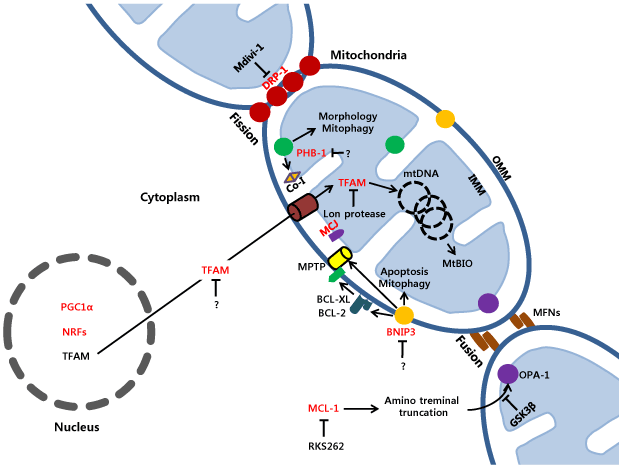
 |
| Figure 1: Targeting molecules related to MtBIO in ovarian cancer to overcome chemoresistance. Important targets are shown in red color. Major regulator of MtBIO, TFAM, synthesized mostly in the nucleus and transported to the mitochondria, where it controls mtDNA replication, maintains coating and packaging of mtDNA. It plays central role for the production of transcripts from different promoters of mitochondrial genome and augments MtBIO. In mitochondrial matrix it is degraded by Lon proteases if not bind with mtDNA. PHB-1 largely controls mitochondrial morphology thus playing a role in structural regulation. It also regulates assembly of respiratory complex 1 and subunits of cytochrome c oxidase and affects mitophagy. MCL-1 takes part in mitochondrial fusion process through the regulation of OPA-1 after amino terminal truncation. MCL-1 may degrade by GSK3β in mitochondrial matrix and can be inhibited in the cytosol using inhibitor (eg. RKS262). MCJ control the regulation of mitochondrial import of essential proteins and transcription factors. BNIP3 plays important roles both in apoptosis and mitophagy through the regulation of BCL-2, BCL-XL and mitochondrial permeability transition pore (MPTP) etc. DRP-1 cause fragmentation of mitochondria through the process of fission. Impairment of DRP-1 activity through inhibitor mitochondrial division inhibitor (MDIVI-1) can disrupt the maintenance of MtBIO. Another master regulator of MtBIO, PGC-1α, and its downstream target NRF-1 also can be targets in ovarian cancer. OMM, outer mitochondrial membrane; IMM, inner mitochondrial membrane; Co-I, Respiratory complex 1; MFNs, mitofusin proteins; OPA-1, optic atrophy 1. |